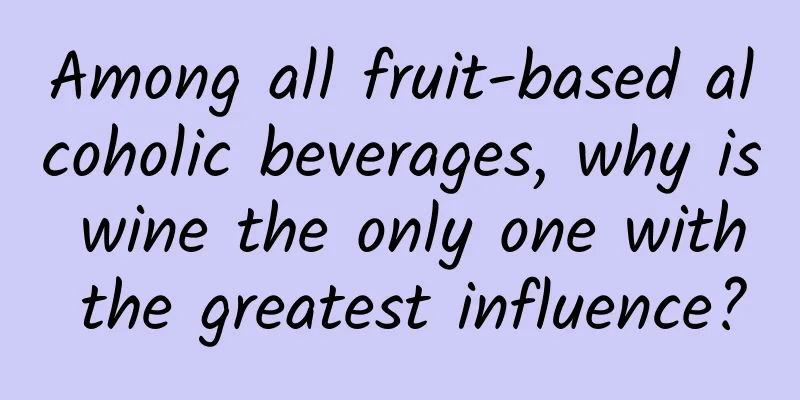Among all fruit-based alcoholic beverages, why is wine the only one with the greatest influence?

|
Written by Wei Shuihua Header image |pixabay In the minds of most Chinese people, fruit wine is roughly equivalent to soft drinks. Its drinking value and economic value are completely incomparable to grain wine. The only exception is wine.
Wine is the most important byproduct of yeast's "domestication" of humans. In order to pursue the excitement brought by alcohol, the earliest people who achieved a surplus of food offered the excess food to yeast to produce this chemical substance that does not provide calories but only stimulates nerves. Grain starch, fructose, lactose...all sugars can be feed for yeast. From gathering and hunting to farming and animal husbandry, yeast has made people greedy for food other than just filling their stomachs, and has also indirectly promoted the development of social structure and productivity. The food residues that cannot be utilized by yeast become part of the wonderful taste of the wine. This is a symbol of the distinction between different types of wine and is also the most fundamental cornerstone of wine culture around the world. The biggest difference between fruit wine and grain wine comes from the fermentation raw materials: starch in grains and fructose and glucose in fruits. The chemical structure of fructose and glucose is simple and can be directly used by yeast; the chemical structure of starch is relatively complex and yeast cannot decompose it. It can only be decomposed into monosaccharides before being processed by yeast. A paradox is that fruit planting is often more troublesome than grains, requiring a lot of manpower for fertilization and pest control, but the solids that can be used for wine fermentation are far less than grains. Therefore, in the history of winemaking, humans have been looking for ways to turn starch in grains into monosaccharides that can be used by yeast. The original meaning of "qu" is wheat that has grown mold and sprouts. The Chinese discovered that after the sprouted wheat was broken and dried into lumps, the mold and yeast flora would be stably preserved in the form of spores. Through repeated attempts, the lumps with the best brewing taste were selected and added to more broken wheat for reproduction and replication. This may be the earliest process of human domestication of microorganisms. Finally, a large amount of stable mixed clumps of mold, yeast and wheat were produced and put into grain, allowing the mold to decompose starch while the yeast produced alcohol. This is the world-famous bilateral brewing method. The Chinese say "qu is the skeleton of wine", which describes this process of building a framework for fermentation. As the koji making technology matured, the status of grain wine in the minds of Chinese people, as well as Japanese, Koreans, and Vietnamese people in the Han cultural circle, has steadily increased, surpassing fruit wine. The poem "fine grape wine in a luminous cup" has never been born again. Instead, there are countless praises for Chinese white wine, yellow wine, Korean soju, and Japanese sake.
This stringent restriction on brewing technology has meant that in the pedigree of Western wines, fruit wines have a much larger market share and a deeper research depth than grain wines. This is a "precious legacy" of the backward brewing technology in history. People have been obsessed with fruit wines, and have even brewed many fine wines using fruits other than grapes. Why do grapes stand out among many fruits? In addition to being easy to obtain and convenient, acidity is the primary reason. The so-called acidity here does not refer to whether it tastes sour or not, but refers to the fact that the pH value of grapes is usually only around 3. In ancient times when there was no large-scale refrigeration, freezing, and pasteurization technology, a low pH value was similar to salting and candied food, which used osmotic pressure to inhibit the growth of microorganisms to preserve food and drinks. However, in the process of pursuing excellence in grape winemaking, Westerners have become more and more familiar with the laws of fruit fermentation. At the same time, the achievements of natural sciences such as physics, chemistry and biology have made great progress. With the invention of pasteurization, the maturity of low-temperature refrigeration technology, and the improvement of juice extraction efficiency, more and more fruits have been included in the family of fruit wine. For example, apple wine.
In addition, Australian perry, Belgian cherry and raspberry wine, New Zealand kiwi wine, and Argentine strawberry wine all emerged in this era. They are closely related to the fruit producing areas and the local people's pursuit of the sublimation of fruit flavor. But in general, the historical background, cultural endorsement and R&D level of other fruit wines cannot be compared with wine. This is the fundamental reason why Chinese people, who have always pursued the "take-it-as-it-is" approach to Western culture, do not understand Western fruit wines other than wine.
It was not until the 11th century that the Crusades brought back the distillation technology invented by the Arabs, and sprouted barley and oats really came into use in Western society: distillation avoided various impurities in grain wine and obtained grain wine with stable quality. For fruit wine, distillation also means a bigger revolution: it breaks through the limitation that yeast will no longer work when the alcohol content exceeds 20%, resulting in more powerful liquors. In the 16th century, the emerging maritime powers Britain and the Netherlands began to colonize the South Asian subcontinent and Southeast Asia. Because of the long journey, the fresh water stored on the ship would stink and become undrinkable after a long time. The crew found that the distilled high-proof liquor had good antiseptic properties and could be used as a life-saving diuretic. In order to make the distilled liquor easier to drink, the winemakers added a berry similar to blueberries, "juniper berries", during the production process, and combined it with various spices such as orange peel, cardamom, licorice, coriander, etc. This is today's gin. In the 17th century, as Europeans entered the Americas for development, the Caribbean region became the world's largest and highest-quality sugarcane planting area. In the process of purifying sugarcane to make sucrose crystals, the colonists found that part of the sugarcane juice could not be crystallized and could only become a syrup with high viscosity and a bit of bitterness. This thing was called molasses at the time. Although it tasted bad, molasses, like starch, could be fermented to make wine. The distilled molasses wine is today's rum. Later, the Chinese soaked the leftover bayberries in "stinky liquor" distilled from sour rice wine, and actually "recycled" them into today's bayberry wine.
|
<<: Chinese names shining on Mercury
>>: Why do men in TV dramas bleed from their noses when they see beautiful women?
Recommend
Is the effect of bidding promotion declining? You must analyze these 8 factors
Nowadays, most of our SEM promotions revolve arou...
Panasonic exhibits 0.45mm flexible battery: smaller than a credit card
The shape of most wireless devices is determined ...
Dongfeng Fengguang 580 Smart Link model debuts at Guangzhou Auto Show: Would you buy a talking domestic SUV?
Judging from the domestic SUV sales ranking for O...
What is the selling price of Baidu's promotional information flow advertising brand zone and how much is it charged?
What are the sales rules? How is it charged? Bran...
Is there a real "tree demon" hiding in the forest? Not only does it scream, it also gives you information.
All living things, when in danger, will convulse,...
National Memorial Day丨We will never forget the grief of our country!
84 years ago today Japanese invaders capture Nanj...
Oculus founder: Virtual reality will replace mobile phones
Today, people queue up for hours to buy smartphon...
KFC’s private domain traffic operation strategy!
Speaking of KFC , many people think it is the bes...
Kuaishou account operation and promotion manual, worth reading!
1. Official information release channels that mus...
Good news for domestically produced Tesla is coming soon. Analysts say that it is a foregone conclusion that the domestic production will be launched this year
Although Tesla has repeatedly denied rumors about...
Musee d'Orsay: a concerto between technology and art
The Musée d'Orsay, which has been open to the...
Xia Peng's 26 Lectures on Business Thinking, the most suitable basic business course for you
Xia Peng's 26 Lectures on Business Thinking, ...
Software is eating the world, and developers’ values are the biggest bug
Original English text: Software Matters in the Wo...
A case study for setting up advertising accounts in the education industry!
In the first half of the year, various segments o...









